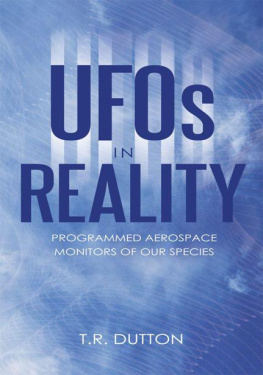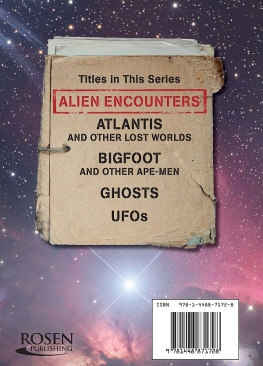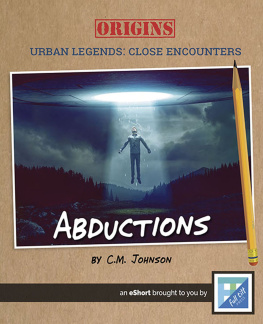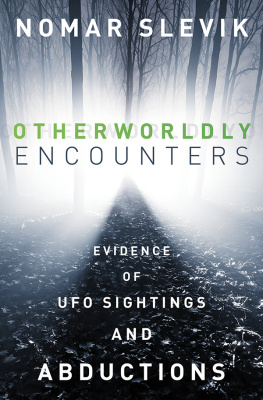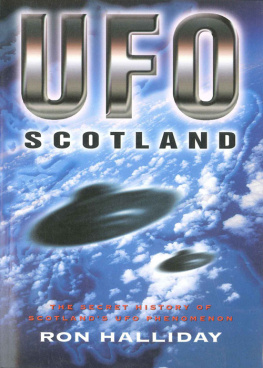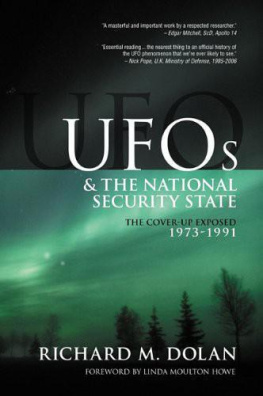UFO S IN R EALITY
Programmed Aerospace Monitors of Our Species
T.R. Dutton

AuthorHouse UK Ltd.
500 Avebury Boulevard
Central Milton Keynes, MK9 2BE
www.authorhouse.co.uk
Phone: 08001974150
2011. T.R. Dutton. All rights reserved
No part of this book may be reproduced, stored in a retrieval system, or transmitted by any means without the written permission of the author.
First published by AuthorHouse 03/9/2011
ISBN: 978-1-4567-7159-1
ISBN: 978-1-4678-9328-2 (ebook)
Any people depicted in stock imagery provided by Thinkstock are models,
and such images are being used for illustrative purposes only.
Certain stock imagery Thinkstock.
Because of the dynamic nature of the Internet, any Web addresses or links contained in this book may have changed since publication and may no longer be valid. The views expressed in this work are solely those of the author and do not necessarily reflect the views of the publisher, and the publisher hereby disclaims any responsibility for them.
Dedicated to Marion, whose patience, tolerance, support and active participation have made this adult-lifetime quest possible.
Contents
Authors Foreword
This book is an account of a broadly based piece of research, with almost all aspects of the UFO phenomenon taken into consideration. The work and discoveries described, herein, will probably pre-empt the eventual declassification of UFO investigations undoubtedly carried out, since the 1950s, by the worlds intelligence agencies. Though the account is largely autobiographical, it describes not only my own work and experiences, but also my interactions with many other people who have, by their experiences, contributed to the research.
As a professional aerospace engineer with longstanding interest, knowledge and expertise in that field, my story begins with a technological study of local UFO reports from the Greater Manchester area during 1967. The reports selected for consideration were those describing strange aerial craft (SAC). After six years, the study became global in scope and grew into a piece of astronautical (space-activities) research. Some fifteen years later, this had produced a vital key to the mysteries; a testable scientific theory, derived from the global data, that became known as the Astronautical Theory (AT) for SAC events. From there, my travels took me to interview eye-witnesses about their experiences, many of which came to be incorporated into the studys database. At an early stage in the investigation I became aware that the objects being described by witnesses were real and artificially-contrived, but utilised technology unable to be humanly reproduced. It began to seem that there existed a wider physical reality, not yet probed by mainstream science and, therefore, unable to be incorporated into present-day human engineering.
As this book will reveal, the AT has been used successfully to explain the nature of many SAC encounters, among them some very famous ones, and to demonstrate the accurately programmed nature of the events.
Throughout the course of more than forty years research much attention has been given, by the media and many authors, to the probability of official cover-ups. The drip-feed releases of Ministry of Defence UFO files in Britain and the public disclosures of ex-US Military personnel, now released from security restrictions over there, have refuelled the clamour for official pronouncements. As the reader will soon discover, this book provides good reasons for official cover-ups and denials. There is little room for doubt that defence and intelligence agencies throughout the world will have carried out work similar to mine and concluded in a similar way that human activity is being constantly monitored by very advanced technology, originating from somewhere out there in space.
One can only hope that the publication of this book will distract public attention away from officialdom and allow such a serious topic to be discussed soberly and without ridicule, in both public and academic arenas. As has been demonstrated on many occasions during the past twenty years, the AT facilitates direct observation of the visiting craft. Several amateur sky-watching groups and at least one astronomer have used its predictions successfully and have informed me of their successes. The existence of this work is known internationally.
T.R. Dutton. 2010
My career within the British aircraft industry began in September 1959, after being accepted as a permanent member of the Special Projects Office of the AVRO (A.V.Roe & Co., Ltd.) Weapons Research Division (WRD). This was based at the scenic Woodford airfield, situated in the green fields of Cheshire, some 10 miles (16 km) south of the city of Manchester. The Special Projects Office was part of a larger department headed by Mr. (later Professor) John E. Allen. He had decided to make good use of my expressed interest in future spacecraft and new propulsion possibilities. A demonstrated ability to visualise and to draw complicated imaginary concepts in three dimensions was another talent he had appreciated. (Computer graphics facilities were still in the realms of fantasy then). During my four years under his direction, John Allen gave me every opportunity to develop my knowledge and talents. He was an advocate for a British Space Programme and was directing his department to investigate future possibilities that would allow Britain to participate actively, within its means, in the exploration of space.
Those were the very early years of the Space Age, when the Americans and Soviets were committing vast resources to the Cold War Space Race and having many failures, even on the launch pads. It was quite clear to us all that more effective and economical ways of launching things into space had to be found before Britain could produce its own launchers in quantity. An attempt was being made to adapt the Blue Streak IBM for satellite launching, but after a few trials, the Government of that time eventually withdrew its support for that project and, also, for the less well-known Saunders-Roe Black Knight and Black Arrow rocket launchers.
In contrast, space efforts within the Special Projects Office were being concentrated in very different directions.
Prior to my presence, John Allen had conceived a provisional cheap launcher for small satellites, which would be carried aloft by a Vulcan bomber before release. That was a practicable possibility. Having already designed, produced and tested the air launched, liquid-fuelled, Blue Steel supersonic cruise missile, the Company had already acquired the necessary skills and expertise to produce an air-launched rocket with a very different purpose.
Looking towards the future, we were encouraged to investigate rocket launchers using exotic fuels (to reduce the physical size of the craft), recoverable stages, and very advanced aerospaceplanes. The aerospaceplanes were winged vehicles. They were intended to take off from conventional runways and then to climb to high altitude using advanced turbojet engines, whilst accelerating to Concorde speeds (Mach 2). From there, ramjets would accelerate them to still higher altitudes and to speeds greater than Mach 5. Finally, rockets would power the rapidly climbing craft into orbit. On leaving its orbit, an aerospaceplane would glide back through the atmosphere (like the Space Shuttle) and land on an airfield. Only the fuel and the satellite would be left behind, instead of all those expensive throw-away rocket stages.
Through his efforts to promote Space-mindedness in Britain, John Allen became known as an expert on such matters by influential people at the Granada Television Studios in Manchester. He was often consulted about the latest developments in the Space Race and, to help them produce a programme about the distant future, he was asked for spacecraft designs that represented our thinking on future manned missions to the Moon and to Mars. Much of that task was allocated to me. With advice on aerodynamics, magnetohydrodynamics (MHD), astrophysics, celestial mechanics, advanced micro-g propulsion units (for use in space) and advanced structures, freely available from the various specialised experts within the department, I was able to produce schemes for those missions. The spacecraft conceived for the Mars mission used nuclear rocket propulsion and one of them looked very similar to the Jupiter Mission ship in the film 2001 - A Space Odyssey, which was produced some years later. All aspects of the missions were considered, especially, how the crew members were going to be accommodated, sustained and protected (from radiation and meteors, for example) during periods of many months in the hostile environment of the Solar System. It was inspiring stuff for a young forward-looking engineer to begin his career with but, alas, all too far ahead in terms of the available technology and funding. (NASA abandoned its National Aerospaceplane project, and the planned Mars Mission is still some years away into the future.)
Next page
